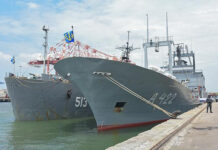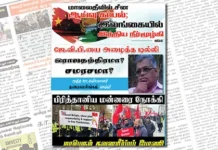An earthquake of magnitude 6.1 struck about 310 km (190 miles) south-southeast of Port Blair, Andaman and Nicobar Islands, the European-Mediterranean Seismological Centre (EMSC) said.
The earthquake has occurred today at around 9.12 am at a depth of about 95 km.
Meanwhile, the Sri Lankan Meteorological department has confirmed that there is no threat to Sri Lanka.
“There is no tsunami threat to Sri Lanka at present with the effect of the above Earthquake. Therefore, the coastal areas of Sri Lanka are declared safe,” Sri Lanka’s National Early Tsunami Warning Centre of the Department of Meteorology said in a press release.
On 26 December 2004, the Indian Ocean tsunami was one of the deadliest natural disasters that hit North-East and South of the island of Sri Lanka. More than 30,000 people were dead.
Following the tsunami, various sources initially reported that LTTE-controlled areas were not receiving aid and were being overlooked by the government (BBC 29 Dec. 2004; AFP 29 Dec. 2004; TamilNet 30 Dec. 2004; ibid. 31 Dec. 2004; Deccan Herald 3 Jan. 2005). Specifically, Asia Times reported that minority Tamils resided mainly in the LTTE-controlled north-east of the country, while the majority Sinhalese resided mainly in the government-controlled areas (5 Jan. 2005). The same source reported that by not granting an equal amount of relief in both areas, the government could potentially alienate Tamils further (Asia Times 5 Jan. 2005), said in a report titled ‘The impact of the 26 December 2004 tsunami on human rights conditions in Sri Lanka’ published by Immigration and Refugee Board of Canada.
The international news agency Associated Press reports the difference between the rescue effort in the LTTE controlled areas and the areas under the genocidal Sri Lankan government.
“Within minutes of the disaster, soldiers of the LTTE were evacuating survivors and pulling bodies from the still-roiling water. In a well-practiced drill, squads set up roadblocks to control panic and prevent looting. Others requisitioned civilian vehicles to move the injured to hospitals. Many donated blood. Teams with digital cameras and laptops moved into disaster zones to photograph the faces of the dead for later identification, then swiftly cremated or buried the corpses. By the end of the first day, the first refugee centers were set up. Meanwhile, in the south, the (Sri Lankan) government was struggling to cope while politicians argued over who was in charge. From the field came isolated reports of corruption and hijacking of relief trucks,” AFP reported at that time.





